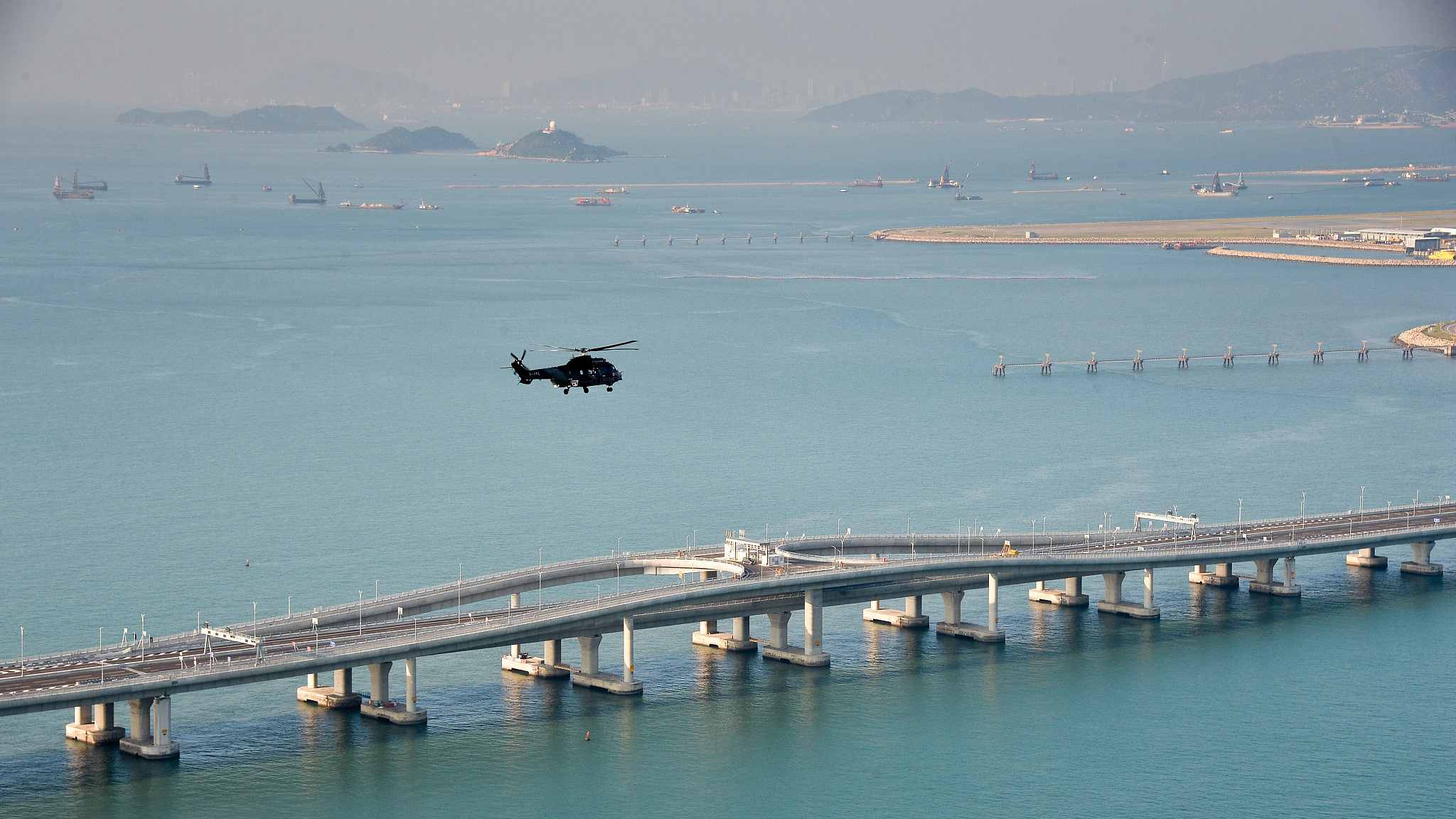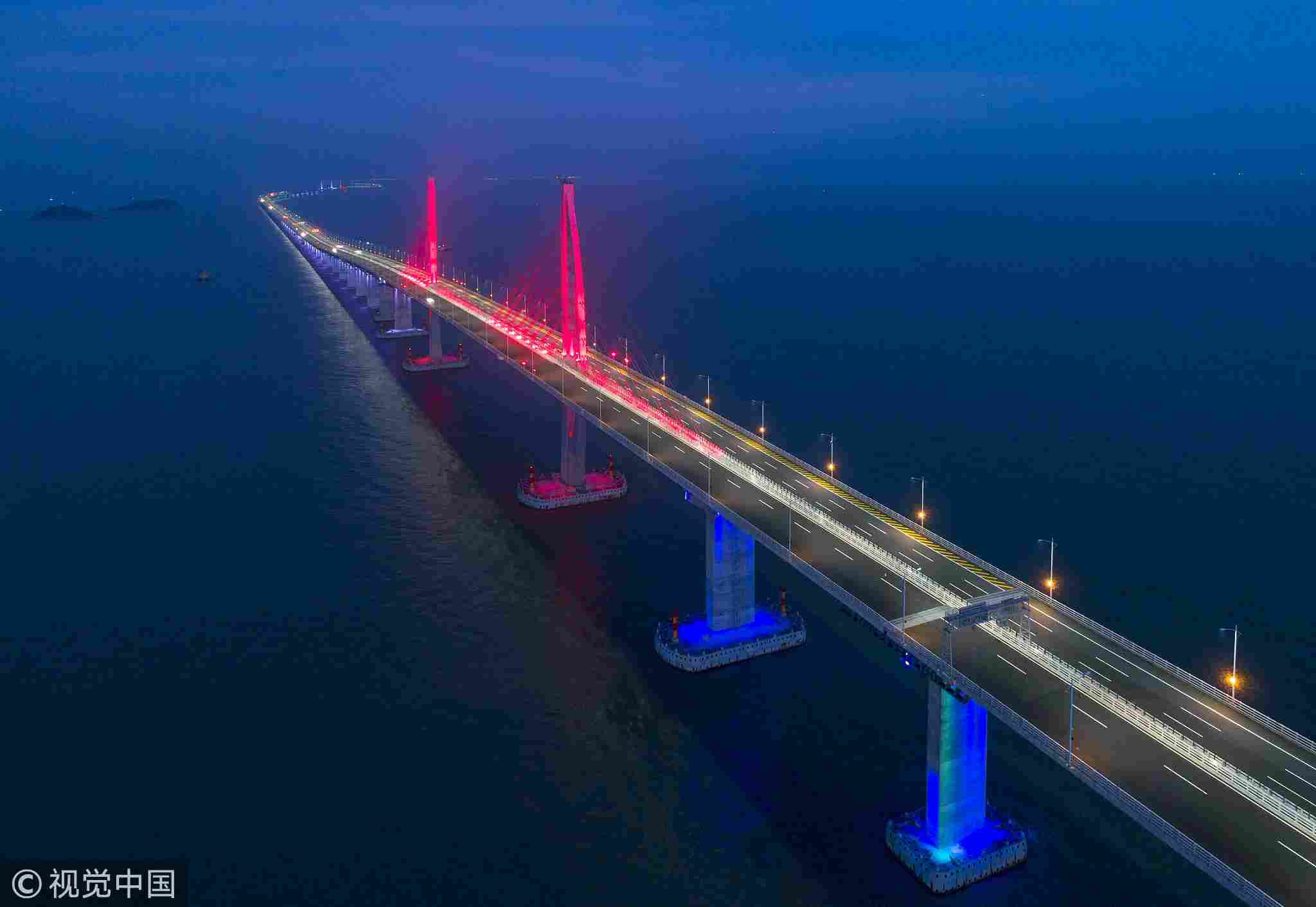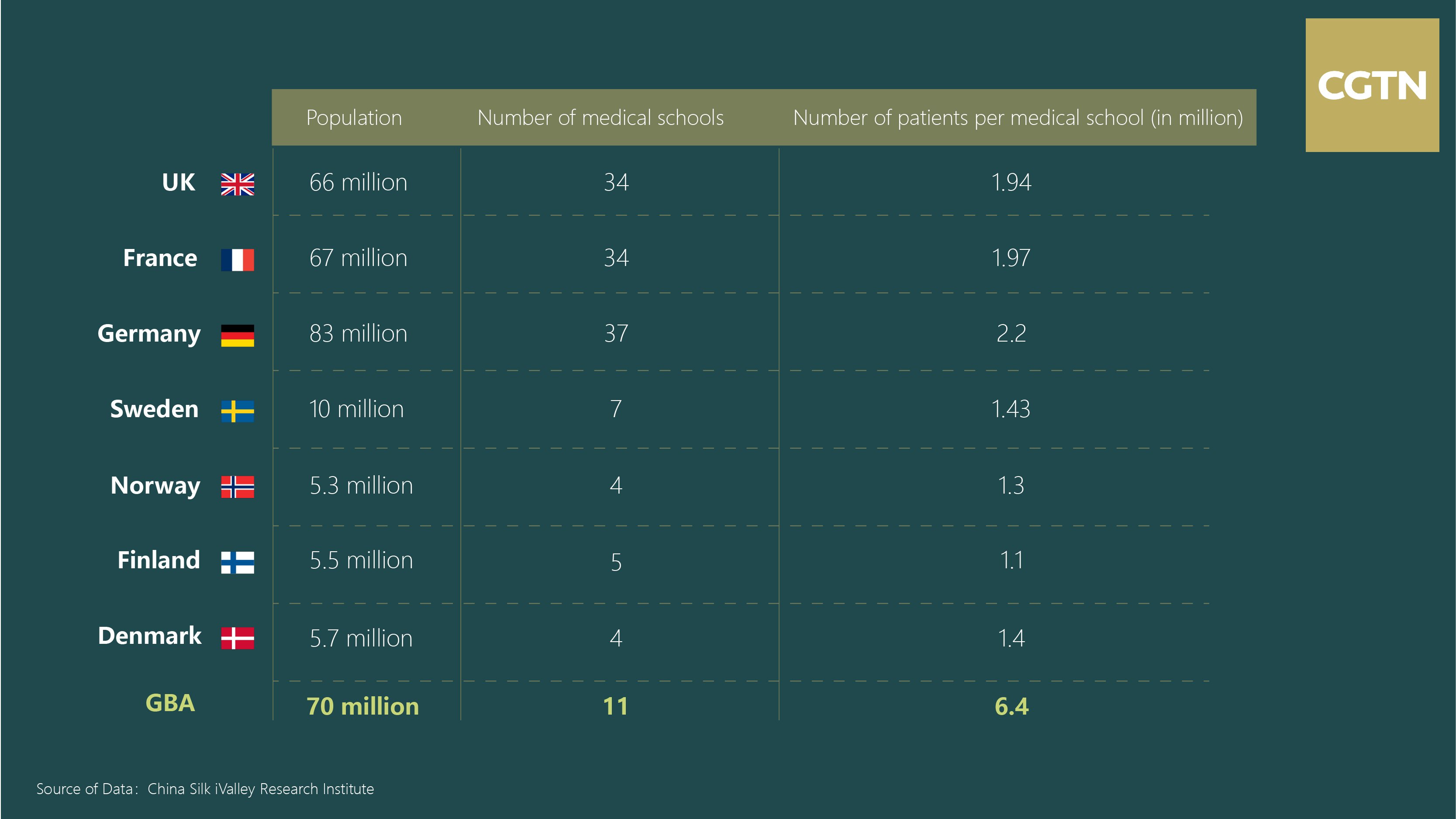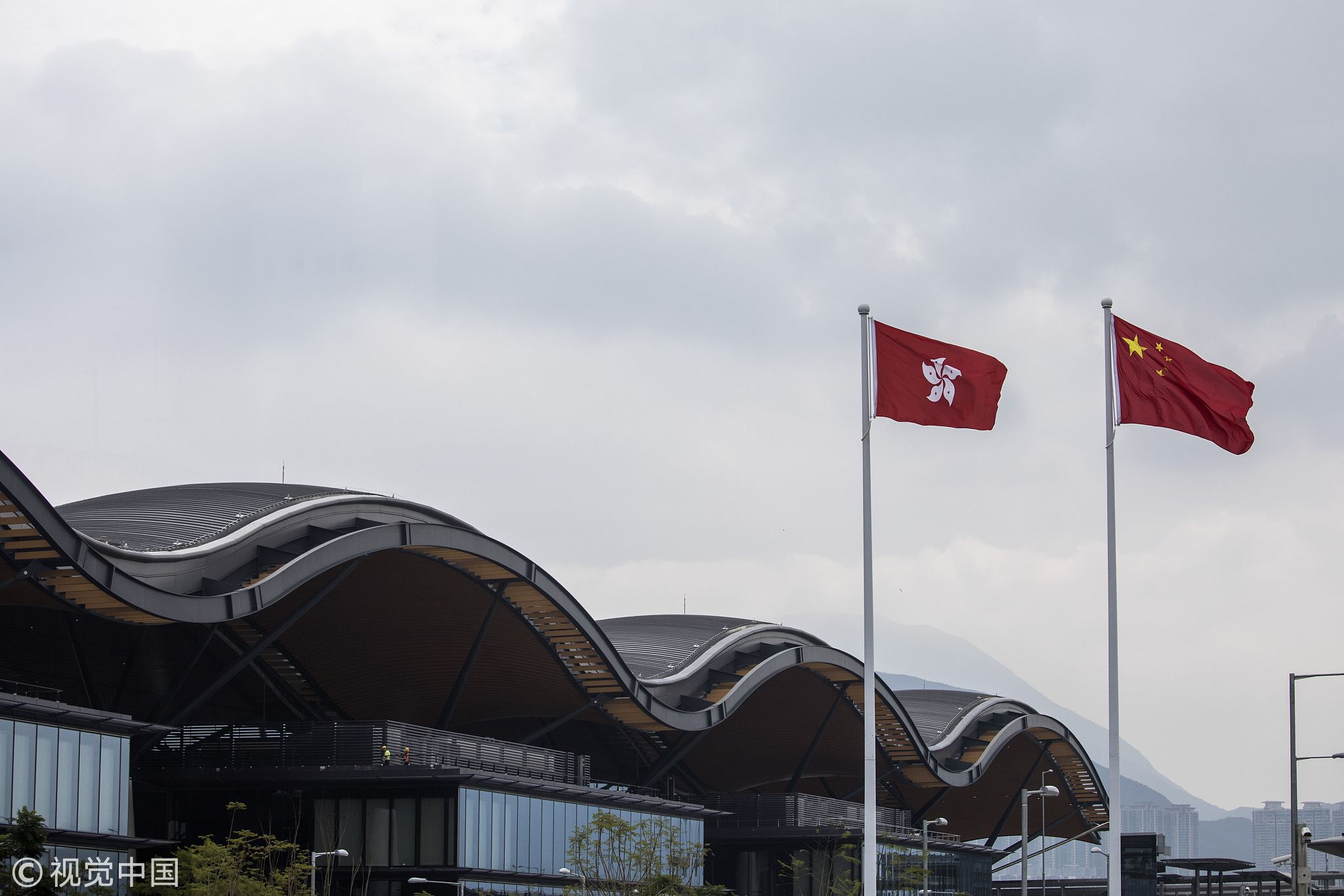
Opinions
08:01, 23-Oct-2018
Opinion: The mega bridge: The incentive for the Greater Bay Area to achieve global eminence
Updated
07:27, 26-Oct-2018
Feng Da Hsuan and Liang Haiming

Editor's Note: Feng Da Hsuan is a chief adviser at the China Silk Road iValley Research Institute and former vice president of research and economic development at the University of Texas in Dallas. Liang Haiming is the chairman of the China Silk Road iValley Research Institute and a visiting scholar at Princeton University. The article reflects the authors' opinion, and not necessarily the views of CGTN.
On Wednesday, October 24, 2018, the breathtaking 55-kilometer-long, a six-lane mega bridge connecting China's mainland and Hong Kong and Macao Special Administrative Regions (SARs) will be open for all cars. The bridge will help China's Greater Bay Area (GBA) of economic prosperity and political diversity to usher in a new era.
It will be interconnected by the world's most advanced “hardware” in an unprecedented manner. Notably, the GBA has over 70 million inhabitants, which is more than the populations of the United Kingdom and France. It is believed that the bridge will help to accelerate the development of the region.
Both of us are Cantonese with long-term associations and familiarity with the region. We have noticed that although the region is relatively wealthy compared to other parts of China, healthcare and education are two parts that the GBA should work on.
First, strengthening healthcare deliveries
Although superficially the mega-bridge can and will greatly ease the transportation congestion of the GBA, it is able to result in a subtle mindset transformation of the population in the region. For one thing, the operated mega-bridge will switch the GBA from rich to affluent.
In this respect, it is able to attract the most outstanding talents in that area from all corners of the world. To measure this quantitatively, the number of medical schools is a measuring yardstick.

The Hong Kong-Zhuhai-Macao Bridge at night. /VCG Photo
The Hong Kong-Zhuhai-Macao Bridge at night. /VCG Photo
It is widely believed that a medical school has three fundamental missions, education, knowledge creation, and social commitment.
When it comes to the third mission, a medical school should provide, for example, disease prevention action and implementation plans as well as the threshold of ascertaining the quality of healthcare delivery. Thus, to ascertain affluence is to consider the number of medical schools in the region.
Comparing to the seven following developed countries, we will shed light on how the bridge contributes to the healthcare deliveries in the region.
According to the following table, in the United Kingdom, Germany, and France, the number of medical schools for each country, on average, serves roughly one to two million people. With 6.4 million residents, the GBA is three times higher than that of the UK, Germany, and France with regards to the population and roughly four times higher than that of Nordic countries.
Undoubtedly, for the GBA population, economic development and being rich is no longer sufficient. The request of being affluent – and providing a higher quality of life are transparently preferred. In this respect, the priority should be given to higher healthcare by increasing the number of excellent medical schools.

The number of medical schools and the population in different regions./CGTN Photo
The number of medical schools and the population in different regions./CGTN Photo
Second, enhancing regional cohesion
Apparently, because of historical reasons, people there have different ideas in terms of culture and politics. A severe challenge for the ultimate success of the plan is how it can ensure GBA's social cohesion, namely how the plan can serve as a bridge not only in terms of the geography but also from the perspective of culture.
To this end, we believe that it is important for youth in GBA, especially university students who will be future leaders, to exchange their ideas through the bridge. Universities provide a perfect platform with young people to increase their cultural ties.
The best example is how Harvard-Yale football contest helps their students to strengthen their ties. It is worth noting that the Ivy League universities are not administratively connected, but together emotionally it formed a formidable intellectual powerhouse for the Northeast United States.

The Chinese flag (right), and the Hong Kong Special Administrative Region flag fly outside the Hong Kong Port Passenger Clearance Building of the Hong Kong-Zhuhai-Macao Bridge tour in Hong Kong, China, on Oct 19, 2018./VCG Photo
The Chinese flag (right), and the Hong Kong Special Administrative Region flag fly outside the Hong Kong Port Passenger Clearance Building of the Hong Kong-Zhuhai-Macao Bridge tour in Hong Kong, China, on Oct 19, 2018./VCG Photo
In the GBA region, the teaching quality of the universities has improved dramatically over the past decades. There are several academically renowned universities in GBA such as Sun Yat-sen University, Jinan University, and Hong Kong University.
It is also worth pointing out that Jinan University (JNU) in the GBA has attracted a great number of students from Hong Kong and Macao. Currently, JNU has some 90,000 alumni working in Hong Kong and Macao and 7,000 students studying on campus.
For example, leveraging JNU's “GBA People's Mind and Livelihood Project” as a testbed, one could extract success experiences and collaborative modalities, from which eventually they could be extrapolated to all GBA universities.
In summary, as we have mentioned from the outset, the “hardware,” the mega-bridge, is now in place to propel GBA to become successful. It makes infinite sense to stand of such a hardware to enact the necessary “software.”
To this end, the connection of the GBA population in action and in a soul is precisely the needed “software”. As the second largest economy in the world, China has the widest market. Playing in this sandbox, both Hong Kong and Macao need to readjust their modus operandi and mindsets to fit in China's internal market's needs which shepherd China seamlessly into the global economy.
Ever since the opening era of China, the GBA consists of disparate political pieces, all making great strides in the respective development. With the mega-bridge, GBA now has the great opportunity to merge in mindset as one. It must be remembered that the ultimate success of GBA is not merely for the Pearl River Delta, it is for China in general.
For that to happen, one must erect the solid foundation with people's well-being as its core. To this end, it is our earnest hope that the suggestions we have proposed here will be steps towards this lofty goal.
(If you want to contribute and have specific expertise, contact us at opinions@cgtn.com.)

SITEMAP
Copyright © 2018 CGTN. Beijing ICP prepared NO.16065310-3
Copyright © 2018 CGTN. Beijing ICP prepared NO.16065310-3